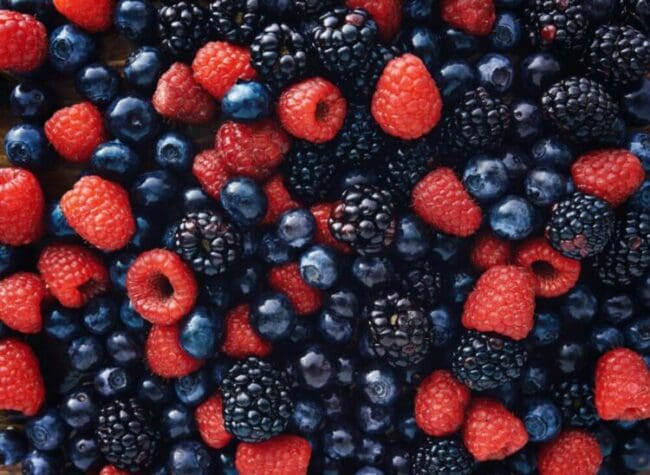
A Berry Special Valentine!
This article was written by Twila Anderson, a student in our Nutrition Diagnostics program.
Berries have been described as ‘nature’s candy’ and there are major benefits to including them in your diet. Valentine’s Day is a perfect time to give berries a try and share with your loved one!
Antioxidants
In our day-to-day life we are exposed to pesky molecules called free radicals. These free radicals can exist both in the atmosphere as well as naturally within our own bodies. Free radicals can negatively interact with cells and other components in our body, which leads to gradual damage of our DNA, proteins, and lipids. An important way to minimize damage is to consume antioxidants. An antioxidant is another type of molecule that will interact with the free radicals, preventing them from interacting with our cells (1). Berries are high in the antioxidant, anthocyanin. This includes strawberries, raspberries, blackberries, blueberries, and cranberries. Anthocyanins have been found to prevent free radical damage which in turn leads to inflammation and chronic diseases such as heart disease, diabetes and certain cancers.
Vitamin C
Although you may recognize vitamin C as being an antioxidant, the benefits are so high that we can consider it in a category of its own! It is most known for its benefits on the immune system, but it also helps keep our skin healthy and helps our wounds heal. We cannot produce vitamin C on our own, so we must get it from our diet (1). The recommended dietary allowance for vitamin C is 90mg for men and 75mg for women. Strawberries have been shown to have some of the highest vitamin c content of all berries. Just 1/2 cup of sliced strawberries provides 49mg of vitamin C, which is already half of the daily value (3).
Fiber
Unfortunately, most people aren’t meeting their fiber needs. In fact, 90-97% of people don’t the recommended 25g of fiber a day (4). Fiber encourages the health of the gastrointestinal tract by feeding our microbiome, preventing constipation, and preventing more serious conditions such as diverticulitis. The daily intake of 2 servings of fiber rich fruits can promote regularity and help to protect against constipation (6). We can promote the health of our gastrointestinal tract with the high fiber content of berries. Below is a list of common berries and the amount fiber in a cup of each (5).
| Berry | Fiber |
| Raspberry | 8g |
| Blackberry | 7.6g |
| Blueberry | 4g |
| Strawberry | 3g |
Low Calorie Snack
Berries are a delicious low-calorie snack that can be included in almost every dietary pattern. If you’re feeling snack-ish, reaching for a hand full of berries instead of other non-nutrient, calorically dense snacks can help keep off extra pounds. One study that showed a correlation between eating whole fruits and weight loss discovered that blueberries and strawberries were among the top five fruits related to weight change (7). To put this into perspective, 1 cup of blackberries contains only 60 calories, whereas a box of Sour Patch Kids candy (40 pieces) has 370 calories (5).
To help make your Valentine’s Day sweet, healthy, and festive, I recommend making this Mixed Berry Oatmeal crumble bars recipe to share with friends and family. These bars contain the delicious blueberries, raspberries, and strawberries that have been mentioned above.
References
- Lobo, V., Patil, A., Phatak, A., & Chandra, N. (2010). Free radicals, antioxidants, and functional foods: Impact on human health. Pharmacognosy reviews, 4(8), 118–126. https://doi.org/10.4103/0973-7847.70902
- Skrovankova, S., Sumczynski, D., Mlcek, J., Jurikova, T., & Sochor, J. (2015). Bioactive Compounds and Antioxidant Activity in Different Types of Berries. International journal of molecular sciences, 16(10), 24673–24706. https://doi.org/10.3390/ijms161024673
- https://ods.od.nih.gov/factsheets/vitaminC-HealthProfessional/#h2
- Dietary Guidelines for Americans, 2020-2025 and Online Materials | Dietary Guidelines for Americans. (2020). Www.dietaryguidelines.gov. https://www.dietaryguidelines.gov/resources/2020-2025-dietary-guidelines-online-materials
- Cronometer
- Dreher M. L. (2018). Whole Fruits and Fruit Fiber Emerging Health Effects. Nutrients, 10(12), 1833. https://doi.org/10.3390/nu10121833
- Dreher, M. L., & Ford, N. A. (2020). A Comprehensive Critical Assessment of Increased Fruit and Vegetable Intake on Weight Loss in Women. Nutrients, 12(7), 1919. https://doi.org/10.3390/nu12071919
